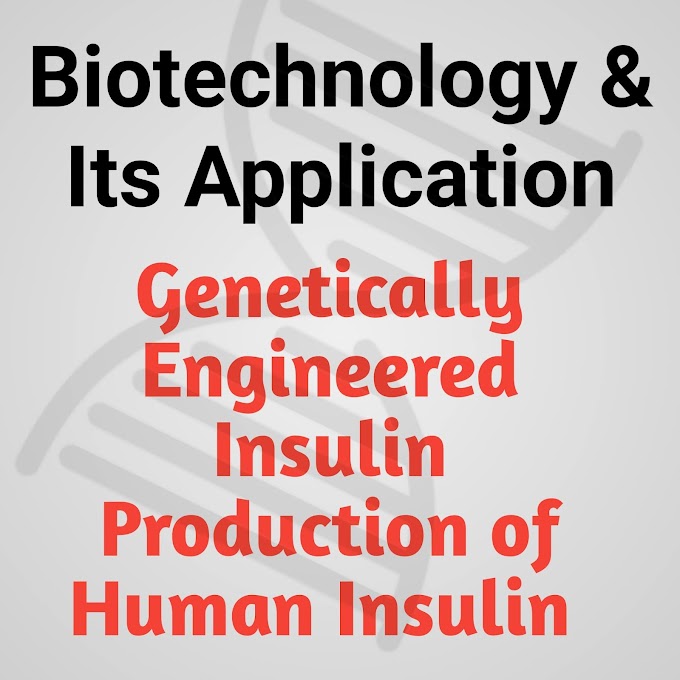👉 NEET Biology Examination
👉 NEET Biology Tips
👉 NEET Biology Study Material
👉 UGC Net Study Material
BIOTECHNOLOGICAL APPLICATIONS IN MEDICINE
- The recombinant DNA technological processes have made great impact in the area of healthcare by mass production of safe and more effective therapeutic drugs.
- Further, the recombinant therapeutics do not induce unwanted immunological responses.
- Now about 30 recombi-nant therapeutics have been approved for human use all over the world.
- In India, 12 of these are presently being marketed.
- Role of Sharpy-Shafer, Banting, Best and Macleod.
- Sharpy-Shafer (1916) first expressed the opinion that diabetes is caused by failure of the islets of pancreas to secrete a substance named by him as insulin.
- Insulin is secreted by the Beta cells of the islets of Langerhans of the pancreas.
- In 1921, Banting and Best succeeded in preparing a pure extract of insulin from the pancreatic islets of a dog with the help of Macleod.
- Banting and Macleod won the 1923 Nobel Prize in Medicine or Physiology.
- They demonstrated that administration of insulin could cure diabetes in human beings.
- Earlier, insulin for curing diabetes used to be extracted from pancreas of slaughtered pigs and cattle.
- This insulin is slightly different from human insulin and brings about some undesirable side effects such allergy.
- Human insulin is made up of 51 amino acids arranged in two polypeptide chains, A having 21 amino acids and B with 30 amino acids.
- The two polypeptide chains are interconnected by two disulphide bridges or S-S linkages.
- An S-S linkage also occurs in A chain.
- The hormone develops from a storage product called pro- insulin.
- Proinsulin has three chains, A, B and C.
- C-chain with 33 amino acids is removed prior to insulin formation.
- Bacteria can not be made to synthesise insulin from its gene because of the presence of introns.
- Bacteria do not possess enzymes for removing intron mediated transcription.
- As stated earlier insulin is produced by the Beta cells of the islets of Langerhans of the pancreas.
- The gene for this protein synthesis is located on chromosome 11.
- In mammals, including humans, insulin is synthesized as a pro-hormone (like a proenzyme, the prohormone also needs to be processed before it becomes a fully mature and functional hormone) which contains an extra stretch called the C peptide.
- This C peptide is not present in the mature insulin and is removed during maturation into insulin.
- The main challenge for production of insulin using rDNA technique was getting insulin assembled into a mature form.
- In 1983, Eli Lilly an American company, first prepared two DNA sequences corresponding to A and B chains of human insulin and introduced them in plasmids of Escherichia coli to produce insulin chains. Chains A andB were produced separately, extracted and combined by creating disulfide bonds to form human insulin (humulin).
- Molecular structure of insulin was worked out by Sanger.Tsan synthesised human insulin for the first time.
- Production of Human Insulin. It involves essentially the following stages:
- Isolation of Donor or DNA segment. A useful DNA segment is isolated from the donor organism.
- Formation of Recombinant DNA (rDNA). Both the vector and donor DNA seg- ments are cut in the presence of restriction endonuclease.
- In the presence of ligase DNA segments of both are joined to form rDNA.
- Production of Multiple Cop- ies of rDNA.
- Next step in the process is production of multiple copies of this recombinant DNA.
- Introduction of rDNA in the recipient organism.
- This rDNA is inserted into a recipient organism.
- Screening of the trans- formed cells.
- The recipient (host) cells are screened in the presence of rDNA and the product of donor gene.
- The transformed cells are separated and multiplied, an economical method for its mass production.
- The various steps and their sequence for the pro- duction of human insulin are depicted in.
- Dr Saran Narang, a scientist of Indian origin, working in Ottawa, Canada was involved in cloning of insulin gene.
- The most famous of the dogs Banting and Best used was one called "Marjorie".
- The first patient of diabetes to be administered insulin was 14- year old Leonard Thompson. Insulin can not be orally admin- istered to diabetic patient be- cause it degrades in the alimentary canal.
- Banting was born on November 14th, Novmember is observed as "Diabetic Day"
- In 1982 insulin (Eli Lilly's Humulin) was the first product made genetically engineered bacteria to be approved for use in Britain and the U.S.A. 1891 hence 14th.
========================================








Please do not enter any spam link or word in the comment box